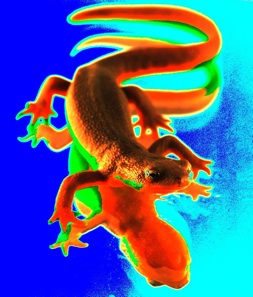My lab is interested in the mechanistic basis of animal behavior. A variety of animal species from diverse groups serve as models. Currently, my lab has three main research tracks. First, we are investigating the evolution of tetrapod (four-footed land animals: mammals, birds, reptiles, amphibians) locomotion by quantifying underwater locomotion using the limbs in salamanders. This may sound odd, but the fossil evidence indicates that the appearance of the tetrapod limb and foot pre-dated the move to land. Thus, one wants a model that approximates the posture of early tetrapods, and salamanders are our best available match. Second, we are examining the biomechanics of prey capture in tarantulas. These large, hairy, ground-dwelling spiders can capture small arthropods (such as crickets) in less than one-tenth of a second. Just how they detect and capture their prey is our current interest. Finally, my lab is working with collaborators at Northern Arizona University and Vassar College to understand how many species of small fish are able to jump on land using a coordinated “tail flip” behavior, even though these fish lack any apparent anatomical specializations for terrestrial movement. My graduate students are working on such diverse projects as how the jumping ability of one of the champions of the fish world (the mangrove rivulus) may be genetically based, how the archer fish controls its spit to knock down prey above the water, and the structural properties of spider exoskeletons. Techniques that we use are high-speed video, electromyography (recording patterns of muscle activity), sonomicrometry, and in vitro measures of muscle work and power output.







